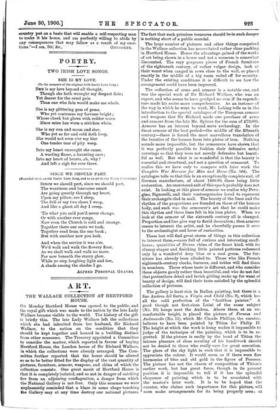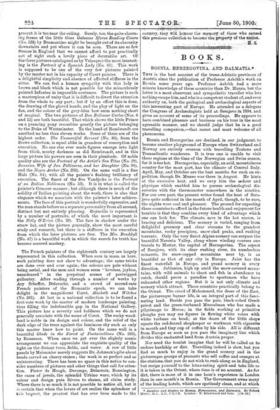ART.
THE WALLACE COLLECTION AT HERTFORD HOUSE.
On Monday Hertford House was opened to the public, and the royal gift which was made to the nation by the late Lady Wallace became visible to the world. The history of the gift is briefly this. The late Lady Wallace left the collections which she had inherited from her husband, Sir Richard Wallace, to the nation on the condition that they should be kept together and housed in a building distinct from other museums. The Treasury appointed a Committee to consider the matter, which reported in favour of buying Hertford House, the London house of Sir Richard Wallace, is which the collections were already arranged. The Com- mittee further reported that the house should be altered so as to be better fitted for the display of the vast quantity of pictures, furniture, armour, weapons, and china of which the collection consists. One great merit of Hertford House is that it is completely isolated, and so not in danger of catching fire from an adjoining conflagration, a danger from which the National Gallery is not free. Only this summer we were angessantly reminded that a blaze in some shops touching the Gallery may at any time destroy our national pictures. The fact that such priceless treasures should be in such danger is nothing short of a public scandaL
The large number of pictures and other things comprised in the Wallace collection has necessitated rather close packing in Hertford House. Hence the advantage gained of the work s of art being shown in a house and not a museum is somewhat discounted. The very gorgeous pieces of French furniture of the eighteenth century, of rather vulgar design, look at their worst when ranged in rows close to the wall, or placed exactly in the middle of a big room railed off for security. Under the existing conditions it is difficult to see bow the arrangement could have been improved.
The collection of arms and armour is a notable one, and was the special work of Sir Richard Wallace, who was an expert, and who seems to have grudged no sum if its expendi- ture made his series more comprehensive. As an instance of the way in which he went to work, Mr. Laking tells us in the introduction to the special catalogue of the European armour and weapons that Sir Richard made one purchase of arms and armour from the late Mr. Spitzer for the sum of £73,000. Armour has an interest beyond mere arclueology. In the finest armour of the best period—the middle of the fifteenth century—there is found the most marvellous translation of the beauties of the human form into plates of iron. Nothing sounds more impossible, but the armourers have shown that it was perfectly possible to fashion their defensive metal coverings so that they were not merely defensive but beauti- ful as well. But what is so wonderful is that the beauty is essential and structural, and not a question of ornament. To realise this we have only to compare with later work the Complete War Harness for Man and Horse (No. 564). The catalogue tells us that this is an exceptionally complete suit, of German manufacture, of about 1460-80, there being little restoration. An unrestored suit of this epoch probably does not exist. In looking at this piece of armour we realise why Peru- gino, Signorelli, and their contemporaries loved to represent their archangels clad in mail. The beauty of the lines and the rhythm of the proportions are founded on those of the human body, and such was the armourer's art that he could make this rhythm and these lines felt in his iron plates. When we look at the armour of the sixteenth century all is changed. Proportion and line give way to florid decoration; then armour ceases to interest the artist, and he cheerfully passes it over to the archa3ologist and lover of curiosities.
These last will find great stores of things in this collection to interest them,—eases full of curious and interesting snuff- boxes ; quantities of Sevres china of the finest kind, with its clumsy shapes and finicking little painted patterns redeemed only by a wonderful deep blue or a cool green. The fur- niture has already been alluded to. Those who like French eighteenth-century clocks, bureaux, and tables will find them in numbers. Those whose taste is different, and who consider these objects gaudy rather than beautiful, and who do not „feel that pretentious detail and lavish gilding make up for want of beauty of design, will find their taste satisfied by the splendid collection of pictures.
The gallery is least rich in Italian painting, but there is a fine Andrea del Saito, a Virgin and Child (No. 9), which has all the cold perfection of the "faultless painter." A good though not first-class Lnini of the same subject (No. 10) hangs next the Andrea. Above these, at an un- comfortable height, is placed the picture of Perseus and Andromeda (No. 11), which Mr. Claude Phillips, the curator, believes to have been painted by Titian for Philip II. The height at which the work is hung makes it impossible to judge of the technique of the painting, which is to be re- gretted. If the picture is really by the baud of Titian the intense pleasure of close scrutiny of his handiwork should not be denied to those who really care for great execution. The glare of the sky light is such that it is impossible to appreciate the colour. It would seem as if there were fine harmonies of blue and old gold in the figure of Perseus. The picture has not the charm of composition of Titian's earlier work, but has great force, though in its present position it is impossible to tell if it has the splendid eloquence of painting which is to be associated with the master's later work. It is to be hoped that the curator, who claims such importance for this picture, will soon make arrangements for its being properly seen; at present it is too near the ceiling. Surely, too, the quite charm- ing fresco of the little Gizen Go2eazzo Sfirza Beading Cicero (No. 588) by Bramantino might be brought out of its obscurity downstairs and put where it can be seen. There are so few frescos-in England that we cannot afford to put practically out of sight such a lovely piece of decorative art. Of the three pictures catalogued as by Velasquez the most interest- ing is the Portrait of a Spanish Lady (No. 88). _ This , work is supposed to be one of the very few pictures painted by the master not in his capacity of Court painter. There is a delightful simplicity and absence of affected stiffness in the sitter. We can feel a human sympathy with this lady in brown and black which is not possible for the miraculously painted Infantas in impossible costumes. The picture is such a masterpiece of unity that it is difficult to divert the attention from the whole to any part; but if by an effort this is done, the drawing of the gloved hands, and the play of light on the fan, and the colour of the grey-blue bow seem nothing short of magical. The two pictures of Don Baltasar Carlos (Nos. 6 and 12) are both beautiful. That which shows the little Prince on a prancing pony resembles greatly the picture belonging to the Duke of Westminster. To the hand of Rembrandt are ascribed no less than eleven works. Some of these are of the highest order. The Unmerciful Servant (No. 86), from the Stowe collection, is equal alike in grandeur of conception and execution. No one else ever made figures emerge into light from thick, murky darkness as did Rembrandt, and in this large picture his powers are seen in their plenitude. Of noble quality also are the Portrait of the Artist's Son Titus (No. 29), Suzanna, Wife of Jan Pellicorne, and her Daughter (No. 90), and the Negro Archer (No. 238). On the same wall is a fine Hals (No. 84), with all the painter's flashing brilliancy of execution. The finest of the five Vandycks is the Portrait of an Italian Nobleman (No. 53). It is in what is called the painter's Genoese manner; but although there is much of the
solidity of Italian painting about the work, there is also that elegance which we associate with the painter's later achieve- ments. The face of this portrait is wonderfully expressive, and the man stands before us a separate personality from all around, distinct but not entirely pleasing. Reynolds is represented by a number of portraits, of which the most important is
the Nelly O'Brien (No. 38). The face in shadow under the
straw hat, and the picture generally, show the most careful study and research, but there is a stiffness in the execution
from which the later pictures are free. The Mrs. Braddyll (No. 47) is a beautiful work in which the search for truth has become assured mastery.
The French painters of the eighteenth century are largely represented in this collection. When seen in mass, as here, such painting does not show to advantage; the same tricks are done over and over again; the colours are pale without being aerial, and the men and women seem "loveless, joyless, unendeared " in the perpetual scenes of periwigged gallantry. After wading through a number of works by Amy Scheffer, Delaroche, and a crowd of second-rate French painters of the Romantic epoch, we can take delight in the magnificent Corot, Macbeth and Witches (No. 281). At last in a national collection is to be found a first-rate work by the master of modern landscape painting, thus filling the indefensible gap in the National Gallery. This picture has a severity and boldness which we do not generally associate with the name of Corot. The rocky wood- land is noble in its design and colour, and the relief of the dark edge of the trees against the luminous sky such as only this master knew how to paint. On the same wall is a beautiful Glade in the Forest of Fontainebleau (No. 283), by Rousseau. When once we get over the slightly scenic arrangement we can appreciate the exquisite quality of the light on the distant trees, fields, and water. A row of little panels by Meissonier merely suggests Dr. Johnson's gibe about heads carved on cherry-stones ; the work is so perfect and so uninteresting. There has been no space in this notice to con- sider numbers of pictures and other things that call for atten- tion. Pieter de Hoogh, Decamps, Delacroix, Bonnington, the cases of jewels, the splendid Urbino ware, which by its colour and design puts Sevres to shame, all claim study. Where there is so much it is not possible to notice all, but it is certain that when the lovers of art realise the splendour of this bequest, the greatest that has ever been made to the country, they Will honour the memory of those who caused this precious colleetloia to become* the property of the uitiori.



















































 Previous page
Previous page